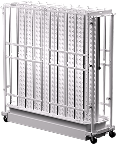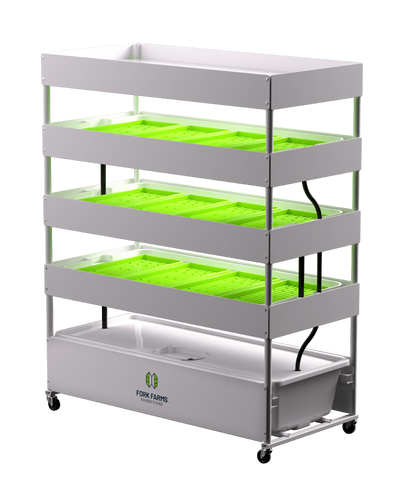The Pros and Cons of Hydroponic Farming
Stemming from the Greek words “hydro” (water) and “ponos” (labor), hydroponics literally means “water working”. Growing hydroponically is a method of growing plants without soil in a nutrient-rich water solution. It is increasing in popularity across the globe, particularly in urban areas and regions that experience extreme weather. Hydroponic farming helps address current issues with food insecurity and the way that fresh food is produced, transported, and distributed within our country and the world.
Indoor hydroponic farms, like our Flex Farm, are a safe and environmentally friendly way to produce significant quantities of fresh lettuce, greens, herbs, and a variety of other foods on-site, quickly, efficiently, affordably, and all year long. Indoor hydroponic farming requires minimal water and energy resources, eliminates food transportation miles, and produces almost zero food waste due to the quality and shelf-life of the produce.
Let’s break down the Pros and Cons of hydroponic farming.
Pros –
The benefits of hydroponics are countless and include:
Fresh Food Anytime, Anywhere
Factors like cold temperatures, droughts, extreme weather, and pest infestation issues prohibit year-round growing. With a hydroponic farming system, vegetables, fruits, and plants can be grown hydroponically year-round because the grower controls the temperature, light, and nutrient supply. This reduces the unknown, and ensures access to fresh food anytime and anywhere for everyone. Some of the best plants to grow in a hydroponics system include herbs, lettuce and greens, tomatoes, peppers, and strawberries.
Sustainable Benefits
Water Conservation –
In conventional farming, much of the water used to grow is lost due to evaporation and poor irrigation. Hydroponic farming uses very little water compared to traditional agriculture because the water solution is reused and recirculated through the system’s pipes. So, even though hydroponic systems depend primarily on water to grow fresh foods and plants, they still use much less water than plants grown via conventional agriculture methods.
Land Conservation –
Growing food hydroponically also requires very little space compared to traditional farming. For example, our Flex Farms need only nine square feet of space to grow 25 pounds of lettuce every 28 days. In traditional farming, plants are spread out, and required to search for soil nutrients. In hydroponics, the nutrients are directly supplied to the roots, so there is no need for the plants to search or grow deep roots. Hydroponic farming can therefore provide nutrient-dense food without taking up significant amounts of space.
Time Management and Higher Yields
Traditional farming requires a great deal of effort and time for farmers to oversee watering, weeding, tilling, etc. And, their yield is unpredictable in both quality and quantity. Since hydroponic farming grows crops in a climate-controlled and monitored environment with special nutrients, plants often grow faster, bringing higher yields. You simply set up the space and system, and watch your plants grow. The initial setup of hydroponic farming does require time and investment, but if the system is managed well, it guarantees long-term high returns. The Flex Farm grows 25 pounds of lettuce every 28 days. And, the food produced by the Flex Farm costs less than $1 per pound. This is a high yield at low cost.
In 2022, our Flex Farms produced 4.1 million servings of food, saved 2.7 million food miles, 337,814 pounds of food waste, and 19 million gallons of water were conserved.
Community Engagement
Hydroponic farming provides a platform for community engagement and collaboration. Schools can partner with local nonprofits or urban agriculture initiatives to cultivate collaborative projects. Hydroponic farms can be set up in community nonprofits to grow fresh produce for hunger relief programs. This provides the opportunity for students, community members, and nonprofit professionals to collaborate and experience the benefits of hydroponics firsthand.
Classroom Learning Opportunities
Hydroponic farming systems in the classroom also offer hundreds of learning opportunities for students in the areas of: STEM, nutrition, agriculture, sustainability, and health. By combining hands-on experimentation in real-world farming scenarios, interdisciplinary learning, and technology, hydroponics provides numerous benefits for students' engagement, critical thinking, and problem-solving skills.
Whether you're an educator, food service professional, or farmer, indoor hydroponic growing systems are an environmentally friendly solution. Here’s how to find the right one for your needs.
Cons –
There is always another side to the story and, of course, challenges exist in hydroponic farming. Some of these include:
Initial Investment
The Initial investment in a hydroponic system seems to be the number one deterrent to those considering growing hydroponically. Hydroponic growing systems rely on technology to run and technology can be expensive. The initial investment in a large-scale hydroponic system specifically can be costly to initiate as systems are large and need a power supply.
Reliance on Consistent Power Supply
Hydroponic systems depend on electricity to power their various components such as grow lights and water pumps. If there is a power outage, the entire system is at risk, which can have a negative impact on what is growing in the farm.
Not Everything Thrives in a Hydroponic Environment
Some plants do not grow properly in a hydroponic setting. These include those that have deep roots like potatoes, carrots, plants that grow tall, and vines (such as grapes).
Organic Certification
There is an ongoing debate in the farming community about whether hydroponic produce can be labeled organic according to USDA standards. Since hydroponics do not use soil, many traditional organic growers feel that they are not eligible. If people want to see the organic certification sticker on their fruit or vegetable, they will not be able to do so at this time on produce that is grown hydroponically.
Final Thoughts
These days, more consumers are choosing to grow their own food, and many are exploring hydroponics to do so. Consumers are also interested in local and sustainably grown foods.
Hydroponic farming is an effective method of growing fresh foods indoors and producing nutrient-rich foods on-site, in less time, with less space, at a lower cost. Although some hydroponic farm systems may come with a number of disadvantages, we believe the benefits outweigh the potential downsides.
For obvious reasons, we at Fork Farms, focus on the many benefits of hydroponic farming vs. traditional agriculture such as yielding more crops with less water, space, and costs. Compared to traditional agriculture, our hydroponic Flex Farm requires zero food miles to be traveled, provides 45 times more food production, and uses 98 percent less water and land. Although we embrace these facts, we also always try to look at the full picture and understand all perspectives as this ultimately helps us create the best hydroponic farms on the market. Hydroponic farming is not a fail-proof or a perfect growing solution for all, but we work to make it more robust every day.
Should you try growing hydroponically? Of course, you should! At Fork Farms, we believe everyone is a farmer. Join in on our food revolution to bring more access to fresh food to more people.























